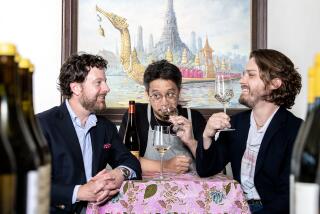More than 600 years of Chianti history in Piero Antinori’s new book
- Share via
Piero Antinori has quite a story to tell in his new book “Hills of Chianti.” The 25th generation winemaker at Antinori, he is backed by more than 600 years of the aristocratic Tuscan family’s history in wine.
“We still like to use the word ‘vintner’ (the old Tuscan vinattiere) — spoken with a small dose of self-deprecating humor — to describe what we do,” he writes.
He begins the book as a proud father, pointing out the accomplishments of his three daughters — Albiera, Allegra and Alessia — who have joined him at Antinori as the 26th generation. It’s something he never dreamed would happen, he says, honestly and touchingly, as he recounts how in the ’80s, “before I saw the light, I assumed that since I had three daughters and my siblings were no longer part of the company, the Antinori family and the company bearing its name would cease to be affiliated with each other. I thought that a dynasty that had lasted for centuries, withstanding bad economic times and political upsets, intrigue at court and parasites on the vine, would simply end after 600 years.”
It was Piero’s father, Niccolò Antinori, who was one of the first to stop using the straw-covered Chianti bottles, called fiascos, that had been on local osterie table for more than seven centuries. In a break with tradition, he decided to bottle his Chianti in a Bordeaux-style bottle: If the French could have their chateau on the label, he could have his Villa Antinori.
Piero Antinori was with his father in 1944 when they rushed to their cellars in San Casciano outside Florence to find that the retreating Germans had machine-gunned the barrels and thousands of bottles of wine, destroying everything. On his first sales trip abroad, to Canada, he met up with the company’s representative there, only to find out later that the jolly bon vivant was a KGB agent who eventually fled the country.
When he became head of Antinori in the ‘60s, he remembers how hard it was to convince European or American importers of the quality of Italian wines. And yet by 2000, the British wine magazine Decanter had named his 1979 Solaia the top wine of the year. “In many ways,” he writes, “Solaia is the wine of my dreams.”
In the pages of this book Piero Antinori, who carries the title Marchese lightly, discusses the challenges of a family business, the sharecropping system in Italy that was only outlawed in 1964, the importance of DOC recognition, and the birth of Antinori’s Super-Tuscan Tignanello (40 years old this year). He pays tribute to the winery’s longtime enologist Giacomo Tachis and chronicles the move to the firm’s stunning contemporary winery in Bargino not far from its original cellars in San Casciano.
There are surprising tidbits tucked into the book here and there. Who knew, for example, that his uncle Mario Incisa della Rocchetta’s now renowned Sassacaia started out as a garagiste wine made for his own use and a small circle of friends? According to Antinori, his uncle would modestly explain, “It’s called Sassacaia. I make it in my garage.”
Until Piero Antinori had a go at selling a few bottles and the Tuscan Cabernet won out over a slew of formidable Bordeaux in a blind tasting.
And so it went. Anyone who loves Italian wines will enjoy spending some hours with this immensely intelligent and thoughtful Tuscan winemaker.
“Hills of Chianti: The Story of a Tuscan Winemaking Family in Seven Bottles” (Rizzoli, $26.95)
Follow @sirenevirbila for more on food and wine.
More to Read
Eat your way across L.A.
Get our weekly Tasting Notes newsletter for reviews, news and more.
You may occasionally receive promotional content from the Los Angeles Times.










